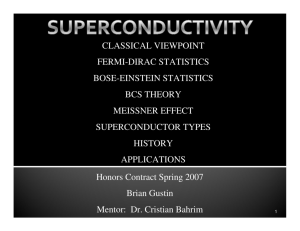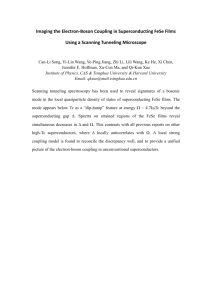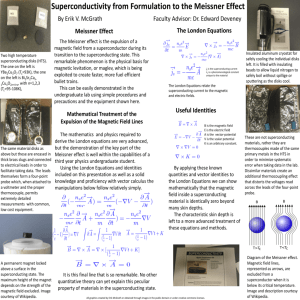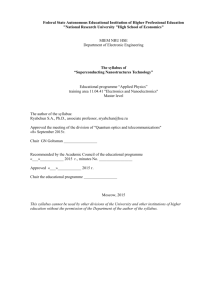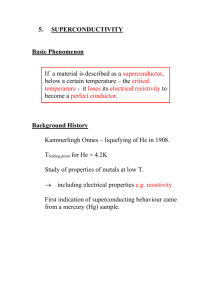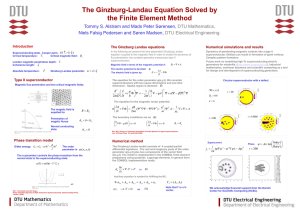SUPERCONDUCTIVITY Basic Phenomenon Background History
advertisement
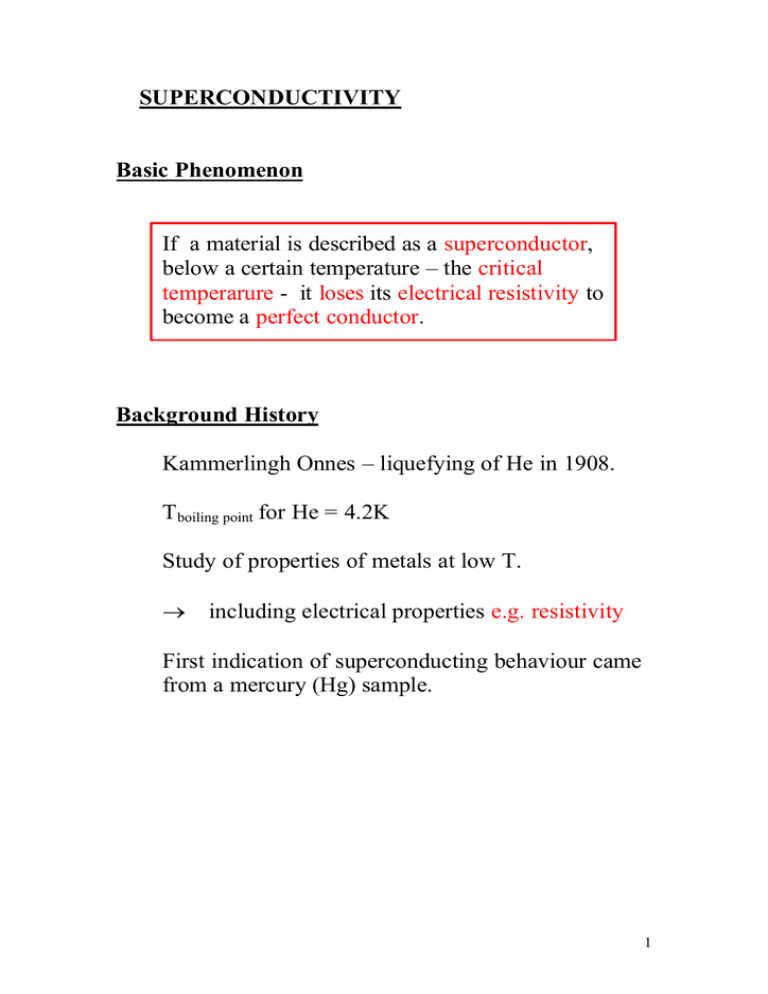
SUPERCONDUCTIVITY
Basic Phenomenon
If a material is described as a superconductor,
below a certain temperature – the critical
temperarure - it loses its electrical resistivity to
become a perfect conductor.
Background History
Kammerlingh Onnes – liquefying of He in 1908.
Tboiling point for He = 4.2K
Study of properties of metals at low T.
→
including electrical properties e.g. resistivity
First indication of superconducting behaviour came
from a mercury (Hg) sample.
1
Resistance of Hg sample versus T
Onnes 1911
R(Ω)
0.125
0.10
0.075
0.050
0.025
0.000
4.0
4.1
4.2
T(K)
4.3
4.4
Resistance falls sharply to zero at critical temp’ Tc (≈
4.2K)
Superconducting state little affected by impurities.
2
Elemental Superconductors
Tc < 0.1 K for Hafnium (Hf) and Iridium (Ir)
Tc = 9.2 K for Nb (element with highest Tc)
Superconducting Alloys
Many metallic alloys were also found to be
superconducting
e.g. MoC (Tc = 14.3K), V3Ga (T c = 16.8K),
Nb3Sn (Tc = 18.05K), Nb3Ga (T c = 21.0K)
In 1972 Nb3Ge
→
Tc = 23.2K
No improvement in Tc for 14 years.
3
“High Tc” Oxides
Large break through in 1986 -
Bednorz and Müller
Tc ≈ 35K for La2-xBaxCuO4
Many similar materials since discovered with higher Tc
YBa2Cu3O7-δ →
[“YBCO”]
Tc = 92K
(1987)
Tl2Ba2Ca2Cu 3O10
→
HgBa2Ca2Cu 3O8+δ →
Tc = 133.5K
Tc = 122K
(1988)
Referred to as “high-temperature superconductors” or
“high-Tc superconductors”.
4
Structure of YBaCuO
Cu atoms
O atoms
Common feature in most of these materials:
crystal structures contain planes of CuO2
Believed to play crucial role in the conductivity and
superconductivity of high-Tc materials
5
Oxygen content is critical
e.g. YBa2Cu 3O7-δ
δ=1
→ YBa2Cu3O6
-
insulator
δ = ∼ 0.6 → YBa2Cu3O6.4 (metal-insulator transition)
metallic
δ just less than 0.6
-
superconducting (T c ≈ 40K)
As δ decreased further, Tc increases.
δ ≈ 0.1
→
YBa2Cu3O6.9
-
Tc = 92K
[Not possible to prepare YBa2Cu 3O7-δ for δ less than ∼
0.1 without changes in basic crystal structure].
6
Advantages/Potential Problems of High Tc Materials
For high Tc oxide materials, Tc > boiling point of N2
“YBCO” Tc = 92K
Boiling point of liquid N2
-
77K
Liquid N2 much cheaper as a coolant than liquid He.
Problems - oxide materials most easily prepared as a
ceramic (i.e. many small crystallites bonded together).
Performance degraded by poor contact between
crystallites.
Brittleness and toxicity of the materials also lead to
problems.
7
How Superconducting?
How superconducting are these materials?
Can we measure a (small) finite resistance in the
superconducting state?
Sensitive method for detecting small resistance– look for
decay in current around a closed loop of superconductor.
I
Set up current I in superconducting loop using e.g. Bfield
If loop has resistance R and self-inductance L, current
should decay with time constant τ
where
τ = L/R
Failure to observe decay
→
upper limit of 10-26 Ωm for resistivity ρ in
superconducting state
c.f. ρ = 10-8 Ωm for Cu at room temp’
8
Magnetic Properties
Superconductors also show novel magnetic behaviour.
They behave in 1 of 2 ways.
Classified into:
Type 1 superconductors (all elementals s/c’s except
Nb)
Type 2 superconductors (high-Tc oxides)
Type 1 Superconductors
Super conductivity destroyed by modest magnetic field –
critical field B0c.
B0c depends on temperature T according to:
B0c(T) = B0c(0)[1-(T/T c)2]
9
e.g. for mercury
B0c (mT)
Mercury
40
Normal State
20
Superconducting
State
0
2
4
T(K)
Critical Current in Superconducting Wire
Existance of critical field B0c implies that for a
superconducting wire, there will be a critical current
Ic [since current carrying wire generates a B-field].
For currents I > Ic, superconductivity is destroyed.
10
Wire radius - a
Current I wire - I
a
r
B
I
B-field lines – concentric circles centred around wire
axis
Can calculate field magnitude using Ampere’s law:
∫ B.dl = µ I
[µ0 = 4π × 10-7 Hm-1]
0
At wire surface:
Typical values:
This gives:
B=
µI
2πa
0
wire diameter = 2a = 1mm
critical field B0c = 20 mT
Ic = 50 A
11
Meissner Effect
What happens to magnetic field inside superconductor?
Consider effect of applying a magnetic field (flux
density) B0 to the material.
In normal (non-superconducting) state
B0
T > Tc
Field passes through material with essentially no change
(or only very small change).
Field B inside material relates to B0 and magnetisation M
of the material by
B = B0 + µ0M
So in normal state M is essentially zero.
12
In superconducting state
B0
T < Tc
Field is excluded from superconductor.
Meissner and Ochsenfeld 1933.
So field B inside superconductor is zero.
i.e. B = B0 + µ0M = 0
→
M = -B0/µ0
So magnetic susceptibility χ = µ0M/B 0 = -1
i.e. perfect diamagnetic
Referred to as Meissner effect.
13
Graphically
B
T < Tc
B0
µ0M
B0c
B0
14
What’s actually happening?
In the superconducting state:
screening currents flow on the surface of the
superconductor in such a way as to generate a field
inside the superconductor equal and opposite to the
applied field.
Helps to explain levitation of superconductor that can
can occur in a magnetic field. Results from repulsion
between permanent magnet producing the external field
and the magnet fields produced by the screening
currents.
15
Type 2 Superconductors
Critical fields B0c found to be small for Type 1
superconductors → potential current densities in
material (before reverting to normal state) are small.
(Most elemental s/c’s)
Certain superconducting compounds →
carrying much higher current densities in
superconducting state.
capable of
These also display different magnetic properties.
16
At low fields, Meissner effect is observed (as described
above).
At critical field B0c(1), magnetic field starts to enter the
specimen. However, field does not enter uiniformlybut does so along flux lines of normal material contained
in superconducting matrix.
B0
T < Tc
superconducting
matrix
flux lines of normal material
Mixed state described as vortex state.
Can persist over a large field range.
As external field B0 is increased above B0c(1), density of
flux lines increases.
Eventually, at second critical field B0c(2), flux fully
penetrates the sample – reverts to normal state.
17
Graphically
µ0M
B0c(1)
B0c(2)
B0
18
Possible Applications of Superconductors
Superconducting Magnets
B
I
Solenoid
N turns
Current I
I
B = µ0(N/L)I
Superconducting Material →
Hence →
Large I
can get large B!
Magnetic Resonance Imaging Unit
Uses large superconducting magnet – can provide
detailed images inside human body.
19
MagLev Transport
Use Meissner effect to get vehicles to “float” on strong
superconducting magnets.
e.g. Yamanasi Maglev Test Line
Virtually eliminates friction between train and track.
20
Thermal Properties
Can describe thermal properties of superconductors using
classical thermodynamics.
For Example:
Can show that there is a latent heat L associated with the
normal - superconducting transition, given by
L = -VTB0c(dB0c/dT)/µ0
[V = volume of superconductor, T = temperature]
Can also show that there is a discontinuity in the specific
heat capacity C at the phase transition (in zero field).
[Good agreement with experimental data for metallic
superconductors].
For metal, C has contribution from lattice vibrations and
an electronic contribution. Measurements of electronic
part of C in superconductors reveals that it varies as
exp{-Egs/kT}
Suggests presence of energy gap Egs. [2∆ in Tanner]
21
Microwave and Infra-Red Absorption
Reinforces idea that an energy gap may be present in
superconductors.
Metal foil
Microwaves
I0
It
Ir
d (∼mm)
Transmission T = I/I0
Reflectivity R = Ir/I0
22
Transmission T
T
Tc
Temperature
T increases as foil is cooled through its transition
temperature Tc. Suggests incident photons don’t now
have enough energy excite electrons across some energy
gap.
Reflectivity R
R
νc
ν
Similarly, if infra-red reflectivity R is measured as
function of frequency ν (for superconducting matertial),
get sharp increase in R at specific ν-value νc.
Again, suggests energy gap given by
Egs = hνc
23
Theoretical Models for Superconductivity
A bit hard ……
Microscopic Theory
Bardeen, Cooper, Schrieffer
1957
First successful microscopic theory – BCS theory.
Key points:
Electrons in a superconductor at low T are coupled
in pairs
Coupling comes about due to interaction beween
electrons and crystal lattice
In (a little) more detail:
one electron interacts with lattice and perturbs it (positive
ions attracted slightly towards electron, thus deforming
lattice). Under certain conditions, this deformation may
be such that the net charge seen by another electron in
the vicinity is positive.
Hence there can be a net attraction between electrons.
Electrons form a bound state, known as a Cooper pair.
24
Electrons in a Cooper pair have opposite spins – hence
Cooper pair has zero spin i.e. acts as a boson
Bosons do not obey exclusion principle → can all
occupy same quantum state of same energy
Consequences: Cooper pairs act in a correlated way.
So, in this collective state, they can all move together.
Binding energy of Cooper pair is largest when all are in
same state. A cooperative phenomenon.
Energy required to break a Cooper pair is
Egs
Referred to as superconducting energy gap.
Theory predicts that Egs temperature-dependent, but at
T = 0 K, Egs = 3.5kT c
Energy gap of Egs opens up in density of states at Fermi
level.
25
